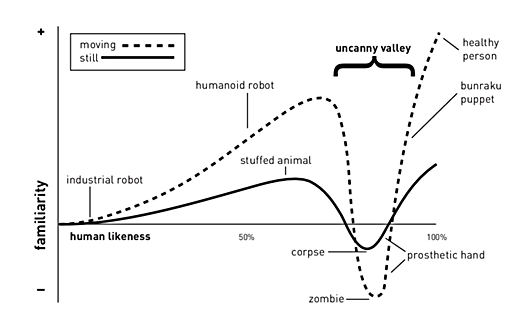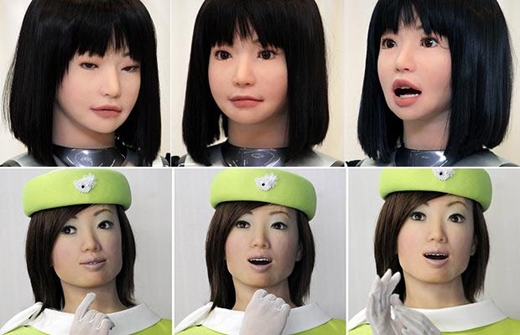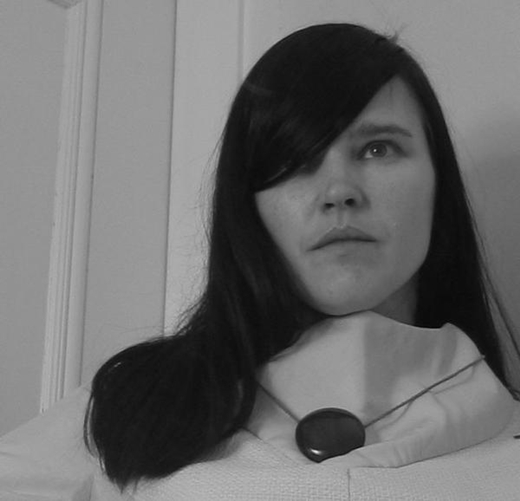Making a valley out of a ditch
typed for your pleasure on 26 January 2011, at 7.21 pmSdtrk: ‘Reinforced Bio-drug use 72mm’ by Masonna vs Speedranch
Back in November, ‘Shouting etc etc’ had a spike in visits due to the piece on Sidore and I on Asylum’s website. Then it dropped off for a few days, but then it accelerated again, only I couldn’t suss where the second wave of referrals was coming from. That is, until I received a comment from a reader, who had explained that Cracked.com had linked to me, in a roundabout way. They had a story, which referenced the edited version of Meghan Laslocky’s article on Salon.com, which links to (what’s left of) my wife’s vanity site, ‘Kitten with a Whip!’, and that, obviously, is linked to me.
So what was Cracked going on about? ‘5 Creepy Ways Humans Are Plunging Into the Uncanny Valley’. Coming in at number five? RealDolls. Yeah, you can doubtless hear my eyes rolling from wherever you happen to be reading this.
Longtime readers are painfully aware that I have issues with the supposed issues that people have with the so-called uncanny valley. For one, noted roboticist David Hanson, who is the closest person the United states has to Japanese roboticist and creator of the Actroid series of Gynoids, Hiroshi Ishiguro, doesn’t take much stock in that school of thought, either. ‘The “uncanny valley” is a theory, but people treat it like science’, he’s quoted as saying, and I’m inclined to agree with him.
Just to remind you: basically, the whole ‘uncanny valley’ thing is a hypothesis developed by roboticist Masahiro Mori around 1970, which states that the closer the appearance of something approaches that of an Organik being, the more likely it is to drastically affect the emotions of those who see it, usually in a negative fashion. Here’s the oft-used visual aid:

The closer a robot gets in appearance, movement, and behaviour to Organik life, the more most people find it unsettling. Which I personally view as being contradictory and nonsensical, but hey.
That’s a brief summary of the uncanny valley hypothesis; you can check out the 12″ extended dance remix over on Wikipedia.
It’s been often argued that the reason why a lot of Organiks are averse to Synthetiks is because they’re either expressionless and emotionless, or the emotions they display are false. I’ve always maintained that if Organiks already understand that a Synthetik human is an artificial one, hence the distinction between ‘Organik’ and ‘Synthetik’ (more on that later), then there shouldn’t be an issue. If a person of reasonable intelligence — yes yes, the numbers are dwindling rapidly, I know — is already aware that the being they’ve encountered is affictitious, then their reaction should be at the most slightly startled, as opposed to the over-the-top feelings detractors claim to have of revulsion.
As regards to the lack of facial expression that a number of current Synthetiks possess, the respective R&D departments are working on it. Humanoid robotics admittedly still has a bit of a ways to go, but in the past decade, it’s come a long way. That’s what’s known as progress. General society seems to have this enormously unrealistic (ha ha) expectation that any Androids and Gynoids that emerge from a lab are going to be completely indistinguishable from Organik humans, and unless they are, society will loudly decry the in-between stages. Despite realism obviously being the goal, that’s simply not going to occur right out of the gate. That’s as if someone in the mid-Eighties, upon seeing those huge brick-style cellphones, decided they still weren’t good enough because they couldn’t watch MTV on the tiny LED screen. I know, I know, ‘what’s MTV’. But again, anyone with a modicum of intelligence would be able to overlook the aesthetic and mobile shortcomings that an artificial human may have, as long as those shortcomings aren’t entirely drastic.
And regarding the programmes that a Synthetik would eventually have that would resemble emotions; again, if you already know the person is a robot, then your suspension of disbelief should theoretically kick in and solve the problem. Besides, Organik humans lie all the time! Why don’t more people have issues with that fact?
Body language interpretation is another factor in the uncanny valley scenario. Those who subscribe to that ‘theory’ cite that their feelings of creepiness (I hate that word) stem from the way current Androids and Gynoids move — again, as the mechanical technology is still being developed, it’s somewhat stilted and jerky. It has been argued that biological humans find less-than-fluid movement to be unpleasant due to centuries of conditioning: if we encounter a person that moves in an unfamiliar manner, alarms go off in our brains saying SOMETHING IS WRONG WITH THIS PERSON AVOID AVOID. However, using that line of thought, why don’t most people recoil in horror when they see someone that has Parkinson’s disease? Or cerebral palsy? Or those prone to epileptic seizures? Well, in less-enlightened times, people did, and pronounced them possessed, or worse. Just as an intelligent society can interpret a person afflicted with a syndrome or disorder as not something to run in fear from, by that logic, someone observing a contemporary Android or Gynoid should be able to say to themselves, ‘ah, that’s more than likely a Synthetik’.
Organik humans can parse the body language of non-human beings, if they’re open-minded, and are given enough time to do so. We’ve discovered that if a cat purrs, and a dog wags his tail, they are more than likely content. We’ve also discovered that different species don’t necessarily display the same emotions in the same fashion — if you see a cat wagging his tail, chances are he ain’t exactly happy, as another example. Now if humans can read, with some degree of certainty, the body language of animals, then there should be no reason Organiks shouldn’t be able to learn the body language of Synthetiks. Especially when, technically speaking, the body language of a humanoid robot would be specifically designed to mimic that of an Organik, and be therefore easier to understand than that of an animal.
One fear that the uncanny valley elicits in a lot of people would be an existential one: for some observers, seeing an Android or a Gynoid — an affictitious person that behaves like and resembles a living Organik being — reminds them that unlike a Synthetik, their own lifespan is limited. Mass-produced Synthetiks also tap into the fear that biological humans are no longer ‘unique’, or ‘special’, or ‘the crown of creation’.
For one, these people are glossing over the fact that Entropy Prevails, no matter if you were born in a womb, or made in a factory. Presupposing that artificial people ‘can’t die’ is akin to thinking your car/microwave/computer will never break down. Granted, you can state that at least with a computer, if the hard drive’s undamaged, you can remove it and pop it into another tower, thereby extending its ‘lifespan’, and with more sophisticated robot technology. one would be able to do the same with an Android or Gynoid. I realise being able to perform that act alone kicks over a wastebin full of philosophical questions, but I’m doing my best to not visit Tangentburg, as I normally do. But I personally think the fact that someone could have a companion that would never become ill or die shouldn’t be a reminder of one’s mortality; instead, their longevity should be celebrated. You could perhaps view it like having children, or better yet, progeny, that go on to do things long after you’re gone, although I’m more than certain there would be some technosexuals that would prefer their afficititious partners go to the grave with them *cough cough*. The Synthetik creations of humankind would continue advancing our ideas and work when our own bodies have given up on us.
As I see it, eventually humanoid robots that look and act sufficiently like biological humans will be treated very similarly to biological humans. There’ll be some provisions, of course, but as the technology continues to develop, the hope is that humanoid robots will be classed as human, albeit a Synthetik human, as opposed to the good ol’ fashioned Organik humans that you’ve doubtless encountered at one time or another. The exact spelling of the term will undoubtedly change; I hold no illusions in that regard. But intelligent members of future generations that are lucky enough to be able to interact with artificial humans on a day-to-day basis will come to regard them as human, but will still need to differentiate them from flesh-and-blood people for the sake of practicality.
Under normal circumstances, it could reasonably be argued that I have a cynical outlook on society; I don’t refer to myself as a pessimist, but the label’s not completely wide off the mark. The one thing that I’m definitely optimistic about, however, is the inevitable arrival of Synthetik people. ‘Uncanny valley’ or not, their presence will occupy some much-needed spaces in commerce, exploration, arts and sciences, and day-to-day living. Quite honestly, believing in the uncanny valley makes about as much sense as being afraid of one’s own shadow, and I think that the more often that Organiks are exposed to and interact with Synthetiks, then those immature phobias will gradually disappear.

Top, HRP-4C Miim; bottom, Actroid Sara. The future’s looking good
‘If a robot appears in every way to possess consciousness, then in my opinion, we should accept that it does’
— David Levy, author and futurist
Random similar posts, for more timewasting:
Any Synthetiks-related news, Davecat? (Oct 2006) on October 26th, 2006
Any Synthetiks-related news, Davecat? (Feb 2013) on February 1st, 2013

















